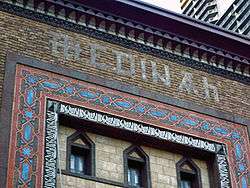Medinah Temple
Built by the Shriners architects Huehl and Schmidt in 1912, the Medinah Temple is a colorful Islamic-looking building replete with pointed domes and an example of Moorish Revival architecture. It is located on the Near North Side of Chicago, Illinois at 600 N. Wabash Avenue, extending from Ohio Street to Ontario Street.
| Medinah Temple | |
|---|---|
 Medinah Temple Facade | |

| |
| General information | |
| Type | Auditorium, rebuilt as a department store in 2000 |
| Location | 600 N. Wabash Ave. Chicago, Illinois United States |
| Coordinates | 41°53′34″N 87°37′38″W |
| Completed | 1912 |
| Design and construction | |
| Architect | Huehl and Schmidt |
History
The building originally housed an ornate auditorium seating approximately 4,200 on three levels. The stage floor extended a considerable distance into the auditorium, and the seating was arranged in a U-shape around it. The auditorium contained an Austin Organ Company pipe organ (opus no. 558), installed in 1915, with 92 ranks, a 5-manual fixed console and a 4-manual movable console (added in 1931). Among the many events that took place in this venue was the annual Shrine Circus. Additionally, WGN-TV used the Medinah Temple for The Bozo 25th Anniversary Special (telecast live September 7, 1986).
The fine acoustics of the Medinah Temple's auditorium made it a favorite site for recording. Many of the Chicago Symphony Orchestra's most famous recordings from the late 1960s (for RCA with then-music director Jean Martinon) through the 1980s (for Decca with then-music director Sir Georg Solti) were recorded there. World-renowned conductor Claudio Abbado recorded Gustav Mahler's Symphony No. 2 with the CSO there in February, 1976. The music to Fantasia 2000 was recorded at the Medinah Temple auditorium from 1994 to 1996.
The auditorium also contained a five-manual, 92 rank pipe organ, Austin Organs Opus 558, installed in 1915. The instrument was the first five-manual instrument built by the firm and one of the largest in the city. It was controlled by a five-manual gallery console and a movable four-manual console.[1] In March 2001 the City Council approved funding to remove the organ for eventual donation to a non-profit organization.[2] The instrument was re-installed in St. Raphael the Archangel Catholic Church in Old Mill Creek, Illinois.[3]
Beginning in late 2000, the exterior of the building was restored and the interior gutted and reconstructed for use as retail space. It was designated a Chicago Landmark on June 27, 2001.[4] It is currently occupied by Bloomingdale's Home and Furniture Store, which opened in 2003. As of June 2019, Bloomingdale's parent company, Macy's, has sold the building to Chicago developer, Al Friedman. The store plans to vacate the building in 2020.[5]
Notes
- "Historic Austin organ to St. Raphael the Archangel Catholic Church (April 25, 2015)". Retrieved 10 August 2020.
- "City Will Save Organ and Medinah Temple". Chicago Tribune. Chicago, Illinois. 23 March 2001. Retrieved 10 August 2020.
- "Our Story: St. Raphael the Archangel Catholic Church". Retrieved 10 August 2020.
- Ryan Ori. "Medinah Temple". City of Chicago. Archived from the original on 2007-06-07. Retrieved 2007-05-18.
- "Landmark Medinah Temple to be redeveloped". Chicago Tribune. Retrieved 2019-08-31.